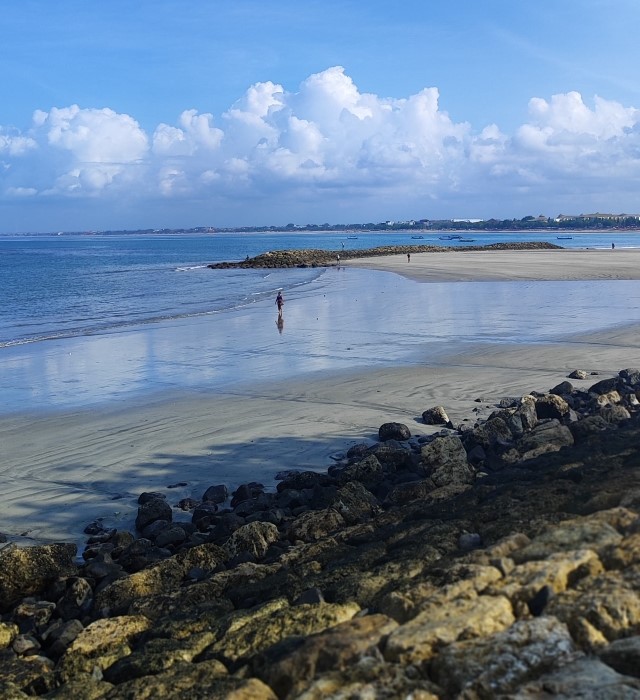Planning a trip to Bali in February? You’re likely wondering what kind of weather to expect. Bali’s tropical climate can be a bit of a puzzle, but I’ve got the insights to help you pack your bags with confidence.
February is smack in the middle of Bali’s wet season, which means there’s a good chance you’ll encounter some rain. But don’t let that dampen your spirits! I’ll guide you through average temperatures, rainfall patterns, and what these conditions mean for your vacation activities.
 Bali’s Climate in February
Bali’s Climate in February
As someone who’s experienced Bali’s weather patterns first-hand, I’ve found that understanding the island’s climate during February is key for anyone planning a trip. As mentioned earlier, February falls within Bali’s wet season, which typically runs from November to March. Despite the greater likelihood of showers, Bali’s tropical allure remains undiminished.
Average Temperatures in Bali
In February, Bali offers a warm, humid climate with average daytime temperatures hovering around 26°C to 30°C (79°F to 86°F). Evenings are slightly cooler but still pleasantly warm and usually don’t require more than a light sweater. Here’s a quick look at the average temperatures:
| Time of Day | Average Temperature (°C) | Average Temperature (°F) |
|---|---|---|
| Daytime | 30°C | 86°F |
| Evening | 26°C | 79°F |
Rainfall Patterns
The rainfall in February can be heavy at times, but it’s typically concentrated into intense, brief downpours rather than persistent, all-day drizzles. Sudden showers are common, but they usually clear up quickly, leaving the rest of the day for you to explore and enjoy. On average, Bali receives about 280mm of rain over 15 days in February, with rain events often occurring in the late afternoon or evening.
Outdoor activities remain popular since mornings are often bright and sunny. It’s advisable to schedule your tours and excursions earlier in the day to make the most of the drier weather. Additionally, having a flexible itinerary can help you adapt to the whims of the weather, ensuring that you won’t miss out on what Bali has to offer.
Humidity Levels
The humidity in February can reach up to 80%, which may feel quite stifling especially for those not accustomed to tropical climates. I recommend staying hydrated and dressing in light, breathable clothing to minimize discomfort. If you’re venturing out, it’s also a good idea to carry a portable umbrella or a raincoat, just in case you’re caught in a spontaneous shower.
Average Temperatures in February
Exploring the intricacies of Bali’s climate in February reveals a fascinating blend of tropical warmth and refreshing breezes. Average temperatures tend to hover between a comfortable 26°C to 30°C (79°F to 86°F), crafting an ideal setting for a wide array of activities. Mornings in Bali are particularly invigorating during this time, with the mercury just slightly lower to offer a fresh start to one’s day.
Despite the wet season’s peak, the warmth of the island persists. The sea temperatures also remain inviting, typically ranging around 29°C (84°F), which is perfect for those looking to dive into a multitude of water-related activities like snorkeling, surfing, and swimming. The evenings carry a slight coolness; a light jacket might just be the perfect accessory for a seaside dinner under the stars.
It’s essential to note that, like many tropical regions, Bali’s temperatures don’t fluctuate widely throughout the day. This stability is a boon for travelers who prefer predictable weather patterns to plan their daily outings. However, prepare for the high humidity levels that accompany such consistent temperatures. This could come as a surprise if you’re not used to tropical climates. Opting for lightweight and breathable fabrics can make a world of difference in enhancing your overall comfort.
For the early risers, the morning temperatures are an absolute delight. The island wakes up to a fresh and balmy climate that slowly warms up as the day progresses. This gradual increase in temperature paves the way for a seamless transition into various outdoor activities or even a leisurely café visit for a taste of the local cuisine paired with the gentle warmth of the Balinese sun.
Rainfall Patterns in February
Despite Bali’s obvious allure in February, I’ve learned that it’s important for travelers to be mindful of the rainfall patterns. This month is smack dab in the middle of the wet season, which typically runs from November to March. Expect to encounter rain, but don’t let that dampen your spirits or your vacation plans.
On average, Bali experiences around 15 days of rain in February, which can translate to a total of 280mm through the month. This may sound substantial, but the showers are usually short-lived and often take place in the late afternoon or evening. This pattern provides ample time to indulge in various outdoor activities during the day.
Morning explorations are prime during this period given that the skies are often clearer. Many travelers, myself included, take advantage of these conditions to venture into Bali’s lush landscapes, visit temples, or stroll along the beaches. However, it’s always a good idea to carry a raincoat or a compact umbrella. Being prepared for sudden showers ensures that you’re never caught off guard.
| Month | Average Rainfall (mm) | Rainy Days |
|---|---|---|
| February | 280 | 15 |
The rain may come and go, but it contributes to the rich, green scenery that makes Bali a tropical paradise. Waterfalls are in full spate and the rice fields glisten with a vibrant green hue that is simply breathtaking. While you might witness overcast weather at times, when the sun peeks out, it transforms the landscape into a sparkling canvas, which is a sight to behold.
Following the rainy spells, the air tends to be a bit cooler, which can be a refreshing change from the usual balmy climate. Evenings after the rain may be more comfortable for dining alfresco or enjoying a beachside walk with a gentler breeze.
It’s also worth noting that while Bali’s sophisticated infrastructure affords comfortable travel, on occasions of heavier downpours, some regions might experience temporary disruptions. Visitors should be aware and maybe plan their itineraries with some flexibility to accommodate nature’s mood swings.
Lastly, the rain doesn’t affect the warm sea temperatures, which hover around the pleasant mark, so water activities are still very much on the cards. Whether it’s diving, snorkeling, or just swimming, the waters remain as inviting as ever.
What to Expect in Terms of Weather Activities
When planning a getaway to Bali in February, you’ll want to tailor your itinerary to maximize the enjoyment of the island’s weather conditions. Expect mornings to offer sunshine and clear blue skies, ideal for beach outings or cultural tours. I’ve found that starting the day early not only beats the crowds at popular tourist spots but also takes advantage of the most predictable weather. By afternoon, the clouds may gather, but this shouldn’t deter any plans. In fact, the rain becomes an exciting feature of the island’s charm.
Outdoor enthusiasts needn’t worry as there’s a plethora of activities that thrive under these conditions. Popular weather activities include:
- Surfing in the warm sea, which remains steady and inviting despite the rainy season
- Exploring the lush terraced rice fields that are particularly vibrant from the rainfall
- Diving and snorkeling which can be excellent given the right conditions and location
- Participating in indoor yoga classes or spa treatments that offer a serene experience while the rain patters outside
- Enjoying the vibrant nightlife in Kuta or Seminyak where the rain rarely impacts the lively scene
The region’s climate influences the timing of these activities. Surfing is best enjoyed in the early hours before the winds shift, while rice field tours can be scheduled when the likelihood of rain is lower. It’s important to remain flexible and ready to adapt your plans.
Moreover, millennia-old traditional temples, shopping at local markets, and culinary adventures await those who are content with strolling under an umbrella. Simply put, no matter the downpour, Bali’s spirit remains undimmed. My experience has taught me that the rain can even enhance the beauty and mystique of the island, giving visitors a glimpse of the tranquility and lushness that Bali is known for. Being prepared with waterproof attire and an adaptable mindset is key to enjoying the full breadth of activities available in February.
Packing Tips for Bali in February
Packing for Bali in February requires a bit more consideration due to the mixed bag of weather. I’ll make sure to list some essentials you should include in your suitcase to tackle the unpredictable climate without compromising on fun or fashion.
First off, lightweight clothing is a must. Bali is generally warm so materials like cotton or linen will help keep you cool during the morning sun. Sleeveless tops, shorts, and airy dresses are perfect for daytime activities. But don’t forget to pack a couple of warmer layers like a lightweight sweater or a long-sleeve shirt. These can be particularly handy during cooler evenings or if you’re venturing into higher altitudes where it can get chilly.
I always recommend bringing waterproof gear. A good-quality rain jacket or a poncho can be a savior during unexpected downpours. If you plan on indulging in outdoor adventures, water-resistant shoes or sandals with a good grip are invaluable. Add a compact umbrella to your bag; it’s small enough to carry around and perfect for quick showers.
Swimwear is non-negotiable when you’re surrounded by Bali’s breathtaking beaches. I suggest packing at least two swimsuits or board shorts so you have a dry one ready at all times. Sun protection is crucial as well; a high-SPF sunscreen, hat, and sunglasses are indispensable given the strong tropical rays.
Bali’s temple and cultural site etiquette require modest dress, so bring along a sarong or a scarf to cover up when necessary. These can also double as a chic accessory or a beach cover-up.
Lastly, for the lively nightlife and upscale dining experiences, you’ll want to include some smart-casual attire. A nice dress or a button-down shirt paired with chinos can easily elevate your evening ensemble.
Remember, it’s not just what you pack but how you pack it. Roll your clothes to save space and avoid wrinkles, and use packing cubes to keep everything organized. Always keep your travel documents and electronics in water-resistant bags for that extra layer of security against the rain. With these items in your luggage, you’ll be poised to enjoy Bali’s offerings, rain or shine.
Conclusion
So if you’re planning a trip to Bali in February, remember that the right preparation is key to enjoying the island’s beauty, no matter the weather. With the tips I’ve shared, you’re all set to experience the best of Bali, from sun-kissed beaches to serene temple visits. Pack smart, stay flexible, and you’re sure to create unforgettable memories in this tropical paradise. Happy travels!
